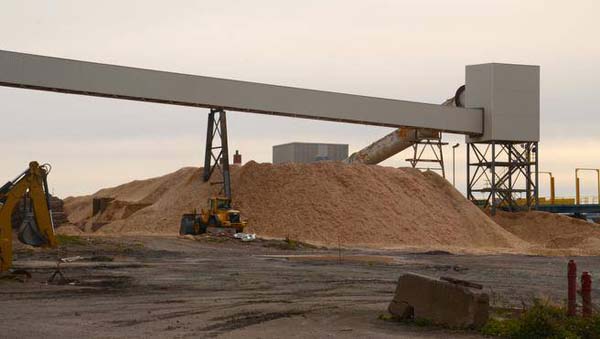Nova Scotia Biomass Project Raising "Green," Forest Industry Concerns
A report this past week by the Herald News, Nova Scotia, Canada, shows chipped wood piled up, waiting to be burned at Nova Scotia Power’s biomass burning power generating station at Point Tupper, Richmond County, N.S. (see photo). About 2,790 hectares are currently "in use" for power generation. That’s a rough estimate of how much woodland will need to be cut annually to feed Nova Scotia Power’s biomass boiler at Point Tupper.
There is a clear but difficult balance between clear cutting forests for raw, fast energy, and processing them to be burned "green" or to be a potential problem for environmentalists and the forest industry. "It seems that more of the fears are coming true than the benefits we had envisioned from that facility," said Kari Easthouse, manager of the Cape Breton Private Land Partnership.
Foresters in northern Nova Scotia are warning that the wood being burned at Nova Scotia Power’s new biomass boiler may be green, but the electricity coming out of it isn’t. The boiler, started by now-defunct NewPage Port Hawkesbury Corp. and sold to Nova Scotia Power, opened during the summer of 2013. Running at peak capacity, which it is a bit shy of now, it burns 670,000 "green" metric tons of wood fiber annually to produce 60 MW of electricity.
"They’re going after anything they can get their hands on to feed that thing," Phil Clark, an Antigonish County sawmill operator, said late this past week. "They’re laying places to waste to feed it."
The boiler was sold to Nova Scotians as a way to throw one stone at two birds. First off, because trees grow back, it would help the province reach its renewable energy targets. Secondly, it would provide a market for wood not immediately wanted for pulp and paper, though the price of Canadian wood chips for its remaining industry have been kept higher in part because of the demand for wood based bio-energy, possibly further damaging the industry.
"By providing a market for the low-quality wood, the idea was that it would create opportunities to do treatments to increase the health and value of the forest," said Easthouse. "That isn’t what appears to be happening," he adds. What does appear to be happening is land getting cut solely to feed the boiler.
According to Nova Scotia Power, half the boiler’s needs are fed by wood waste from Port Hawkesbury Paper, sawmills, and other woods operations. That leaves about 335,000 metric tons of sustainably marked forest that are cut to feed it.
A rough industry average in northern Nova Scotia is that you get about 120 metric tons of wood fiber off a hectare. Divide 335,000 metric tons by 120 and you get 2,792 hectares getting cut every year for the foreseeable future to be burned for electricity in a furnace that works at about 74% efficiency.
"You’ve got to be careful with averages," Allan Eddy, associate deputy minister at the Natural Resources Department, warned late last week. "If you shoot two feet in front of a duck and then two feet behind a duck, on average, that duck is dead."
However, Eddy acknowledged that land is being cleared to feed the biomass boiler. He painted it as a matter of economics that couldn’t have been predicted before the plant opened and that is likely to change for the better in years to come.
Eddy said the shakeup of the province’s forest industry over the last five years has resulted in a severe decline in the province’s harvesting capacity. The NewPage Port Hawkesbury bankruptcy and the closure of Liverpool’s Bowater Mersey mill resulted in a lot of harvesting contractors jumping ship from the forest industry.
"For every 10 logs that the mills need cut, there’s the capacity to cut seven or (seven and a half) logs," Eddy said. That puts a premium on harvesting capacity. He said Nova Scotia Power has an obligation to its ratepayers to get wood fiber as cheaply as possible.
The cheapest way is to clear land, not selectively harvest, techniques the wood based bioenergy industry will have to learn while remaining productive and profitable in order to work in harmony with environmentalists as well as fellow forest product producers who do not want to see the price of wood chips rise as a result of any new projects.
TAPPI
http://www.tappi.org/

